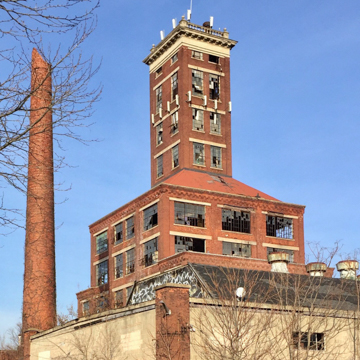You are here
Remington-Union Metallic Cartridge Shot Tower
The Remington-United Metallic Cartridge Shot Tower, once the tallest building in the state, was designed for the production of lead shot. Completed in 1909, and in use for nearly eighty years, the Shot Tower is one of less than a dozen such surviving structures in the entire world. It is thus of great significance not only to the State of Connecticut, but to worldwide industrial heritage.
The principle behind the building is simple and depends upon a late eighteenth-century discovery by Englishman William Watt. Prior to this point, lead shot for use in firearms was typically cast in molds, a slow and labor-intensive process that did not produce shot of a uniform size nor of the smooth texture essential to an accurate trajectory. In 1782, Watt discovered that pouring liquid lead through a sieve from a great height into a large container of water produced reliably spherical shot without any seams. The drops of lead formed spheres as they fell, which were in turn cooled by air, and then solidified without any deformation by the final plunge into water. The form of the tower was necessitated by a simple principle: the greater the height of the sieve above the water, the better and more uniform the results. Watt evidently converted his own house in Bristol into a manufactory by adding a tower to the top (in a Gothic style to “remind citizens of the prospect of Westminster Abbey”) and by cutting holes in the floors. His discovery made him wealthy, and led to a revolution in the production of shot for firearms.
For a variety of reasons related to transportation access, material availability, and ingenuity, by the mid-nineteenth century Connecticut was known for its manufacturing prowess. Firearms were a particular area of expertise, and at one point, the state had two shot towers: the second, which no longer survives, was constructed by Winchester Arms in New Haven in 1912. Once surrounded by 40 acres of brick industrial buildings (313 in all), the Remington-UMC shot tower now stands alone, overlooking mostly empty lots. Ten stories tall and visible from the railroad tracks, it is constructed of brick, concrete, and steel with large, steel-framed windows throughout to light the complex processes inside. It rises in a stepped series of blocks: the lower four-story block is five bays wide with a flat roof; the center two-story block is three bays wide and topped by a pyramidal roof; and the final tower structure is a narrow two bays with a flat roof. The overhanging dentiled cornice was once topped by a balustrade; the view from the highest point in Bridgeport must have been breathtaking.
Inside, the top story held melting vats for the lead, which was poured into a huge sieve, forming a “shower of hissing lead” on its way down shot tubes through the nine-story space to the water tanks below. Once there, the shot was pulled up several stories by a vertical conveyor, and then dropped into a series of polishing and sorting machines housed in the blocky, stepped lower stories, finally coming to rest on the ground story in storage tanks. By the early twentieth century, this manufacture had been mechanized to such an extent that Remington could boast in 1912 that they processed daily 150 tons of metal into “cascades of shot” totaling “twelve hundred million—one and one-fifth billions—of shot pellets.”
Remington moved its operations to a new ammunitions factory in Lonoke, Arkansas, in 1970, and relocated its headquarters to Wilmington, Delaware, in 1984. By the end of the 1980s, all production had ceased in this location and the industrial complex was abandoned. The dilapidated shot tower is all that remains on the site today. As of 2020, the City of Bridgeport has begun plans to preserve the shot tower for future development.
References
Minchinton, Walter. “The Shot Tower.” The Shot Peener 7, no. 3 (Fall 1993): 22-25.
Remington Arms-Union Metallic Cartridge Co., “A Visit to the Bridgeport Plant,” in A New Chapter in an Old Story. Privately published, 1912.
Roth, Matthew. Connecticut. An Inventory of Historic Engineering and Industrial Sites. Washington, D.C.: Society for Industrial Archaeology, 1980: 3-4.
Writing Credits
If SAH Archipedia has been useful to you, please consider supporting it.
SAH Archipedia tells the story of the United States through its buildings, landscapes, and cities. This freely available resource empowers the public with authoritative knowledge that deepens their understanding and appreciation of the built environment. But the Society of Architectural Historians, which created SAH Archipedia with University of Virginia Press, needs your support to maintain the high-caliber research, writing, photography, cartography, editing, design, and programming that make SAH Archipedia a trusted online resource available to all who value the history of place, heritage tourism, and learning.














